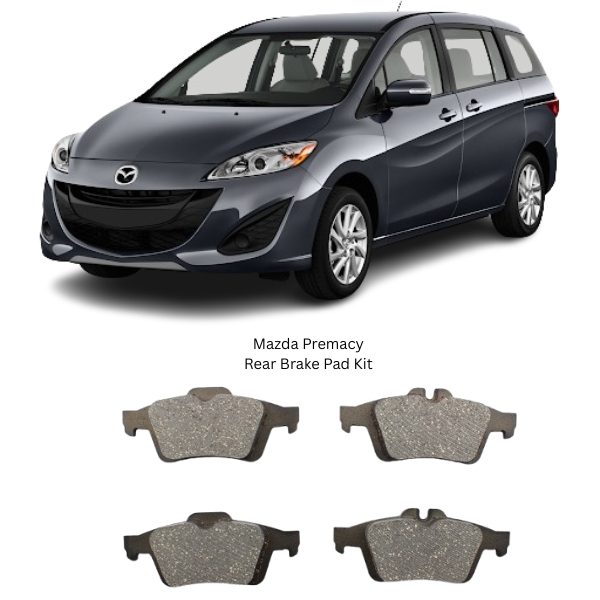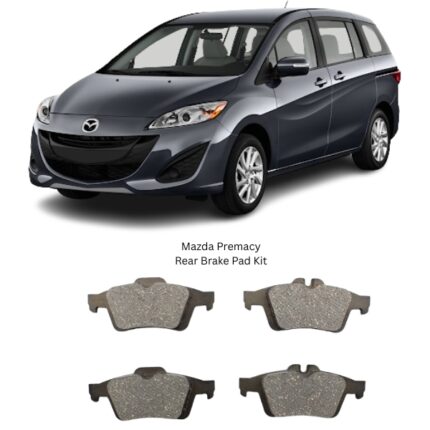Get Mazda Premacy Rear Brake Pad Kit D3132 in Kenya
A Rear Brake Pad Kit is a vital component of a vehicle’s braking system, responsible for safely bringing the rear wheels to a stop when the brake pedal is applied. These pads work by pressing against the brake discs (also known as rotors) to create friction, slowing down or halting the wheel’s rotation. Though often overshadowed by front brake components, rear brake pads play a crucial role in ensuring balanced braking performance, vehicle stability, and overall safety.
Function and Operation
When a driver presses the brake pedal, the vehicle’s braking system activates hydraulic pressure that pushes the brake calipers onto the brake pads. In turn, these pads clamp down on the rotating brake discs attached to the wheel hub. The friction generated during this process converts the kinetic energy of the moving vehicle into heat, thereby slowing down or stopping the car.
The rear brake pads are specifically designed to manage a proportion of the vehicle’s stopping force. While the front brakes typically handle the majority (about 60–70%) of the braking load due to weight transfer during deceleration, the rear brakes stabilize the vehicle, reduce stopping distance, and help prevent rear-end instability.
Kit Components
A Rear Brake Pad Kit generally includes:
-
Brake Pads (Left and Right): These are the friction elements that directly press against the rotors.
-
Anti-rattle Clips / Shims: These reduce vibrations and noise during braking.
-
Wear Indicators: Either mechanical or electronic, to alert the driver when the pads need replacement.
-
Lubrication Grease (in some kits): Helps to reduce squeal and ensure smooth caliper movement.
-
Hardware Kit (optional): Includes pin boots, guide pins, or springs depending on vehicle application.
All parts in the kit are engineered to meet high-quality standards to ensure long life, consistent performance, and safety.
Material Composition
Brake pads are made of high-friction materials bonded to a metal backing plate. The three common types of friction materials used are:
-
Semi-metallic: A blend of metal fibers and other materials. These provide strong braking performance and heat resistance but may produce more noise and wear on rotors.
-
Ceramic: Known for quiet operation, long lifespan, and minimal dust production. These are ideal for everyday driving.
-
Organic (Non-Asbestos Organic – NAO): Made from natural fibers, resin, and fillers. These are soft and quiet but wear faster and are less heat-tolerant.
The selection of material affects braking efficiency, durability, noise levels, and rotor wear.
Importance in Vehicle Safety
The rear brake pads, while handling less braking force than the front, are instrumental in:
-
Maintaining Vehicle Balance: They provide the necessary rear-end stopping power to avoid over-reliance on the front brakes.
-
Preventing Oversteer/Understeer: Properly functioning rear brakes help avoid erratic vehicle behavior during hard stops or emergency maneuvers.
-
Optimizing ABS Functionality: Anti-lock braking systems rely on all brakes working in sync. Worn rear pads can compromise ABS performance.
-
Towing and Load Handling: For trucks or vehicles carrying heavy loads, rear brakes manage more braking load and help prevent instability.
Signs of Worn Rear Brake Pads
It’s essential to inspect and replace rear brake pads before they become dangerously worn. Common indicators include:
-
Squealing or Grinding Noise: A high-pitched squeal or grinding indicates that the pads are worn down to the metal.
-
Reduced Braking Efficiency: The vehicle may take longer to stop, or the brake pedal may feel soft.
-
Brake Warning Light: Many modern vehicles have sensors that trigger a warning light when pad thickness is too low.
-
Uneven Braking or Pulling: If the car pulls to one side during braking, one pad may be more worn than the other.
-
Excessive Brake Dust: Accumulation of black dust on the wheels may suggest pad wear.
Prompt attention to these signs ensures braking performance and prevents rotor damage.
Installation and Maintenance
Installing a Rear Brake Pad Kit typically involves:
-
Lifting the Vehicle: Secure the car with jack stands and remove the rear wheels.
-
Removing Calipers and Old Pads: Carefully unbolt the caliper and remove the worn pads.
-
Inspecting the Rotors: Check the surface for grooves, scoring, or warping. Resurface or replace if necessary.
-
Installing New Pads and Hardware: Apply grease to the back of the pads and install any new clips or pins from the kit.
-
Reassembling the Brakes: Bolt the caliper back in place, ensuring everything is torqued to spec.
-
Testing the Brakes: Before driving, pump the brake pedal to restore hydraulic pressure and perform a low-speed test stop.
Mechanics recommend replacing pads in pairs (both left and right sides) to ensure consistent braking. If one side wears faster, it could indicate a caliper or alignment issue.
Lifespan and Replacement Interval
The lifespan of rear brake pads depends on:
-
Driving habits: Aggressive driving or frequent braking wears pads faster.
-
Vehicle type and weight: Heavier vehicles or those used for towing experience more brake wear.
-
Road conditions: Hilly, urban areas require more braking than flat highways.
Generally, rear brake pads last 30,000 to 70,000 kilometers, though this can vary. Regular inspections—especially during tire rotations or oil changes—help monitor pad condition.
Advantages of a Quality Rear Brake Pad Kit
Investing in a premium brake pad kit ensures:
-
Consistent Stopping Power: Reliable friction material guarantees safe stops in all conditions.
-
Reduced Noise and Vibration: High-quality pads come with shims and insulators that minimize brake noise.
-
Longer Rotor Life: Good pads wear evenly and reduce harsh contact that could damage rotors.
-
Improved Driver Confidence: Knowing your braking system is in peak condition gives peace of mind.
Additionally, modern kits are engineered to meet OE specifications, ensuring a precise fit and optimal performance for specific vehicle models.
Follow us on Facebook for more parts.




